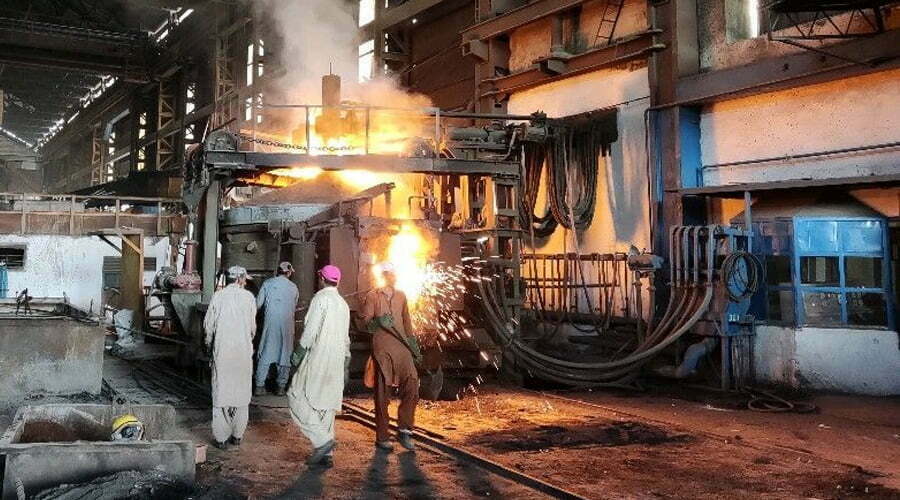About EAF Electrode Conditioning System
EAF electrode conditioning system consists of self-baking electrode, electrode holder, electrode lifting device and electrode pressing and releasing device.
Self-baking Electrodes
The self-baking electrode consists of an electrode shell and an electrode paste filled in the shell (anthracite, coke, graphite and coal tar pitch etc. are mixed in proportion and pressed into a block).
The electrode shell is a cylinder made of 1.5-3mm thick steel plate. Several ribs are welded in the cylinder, and some round holes or small tongues are punched out on it, so that the electrode paste can be well combined with the electrode shell. , to achieve good electrical conductivity.
With the continuous consumption of the electrodes, the electrode shells should be welded one by one, and the electrode paste should be filled regularly.
The electrode paste used is usually added in bulk, or added after preheating into a thin paste.
During the production process of the electric furnace, the electrode holder is self-baked by the Joule heat generated when the current passes and the conduction heat in the furnace. The function of the electrode holder is to transmit a large current to the electrode and keep the electrode at a certain height. Sintered state.
It is mainly composed of pressure ring, copper tile, guide sealing cylinder, etc.
The eaf electrode adjustment system works under the condition of high temperature and strong magnetic field.
With the expansion of the capacity of the electric furnace and the diameter of the self-baking electrode (the maximum diameter of the self-baking electrode has reached 2000mm), the structure of the electrode holder has been continuously developed and improved, and the clamping and loosening of the copper tiles are mostly operated by hydraulic remote control.
There are three main types of clamping methods for copper tiles: one is conical ring type, the other is bellows type, and the third is capsule type.
The former is to use the 6°~15° cone surface between the pressure ring and the copper tile. Under the hydraulic cylinder or mechanical transmission, the pressure ring is lifted and lowered to clamp or loosen the copper tile. This method has a simple structure, but its function The force on each copper tile is uneven.
The latter two are corresponding to the position of each copper tile in the pressure ring, install a bellows or rubber bladder, use hydraulic pressure to control the elongation or shortening of the bellows, and the expansion or contraction of the bladder to clamp or loosen the copper tile. , the force acting on each copper tile by these two methods is relatively uniform.
The copper tile is made of red copper material, and the copper pipe for water cooling is cast in it;
There is also a method of using red copper forging and then drilling holes for water cooling, which can obtain good electrical conductivity and cooling effects and improve service life.
The guide sealing cylinder (also known as the water-cooled large sleeve) is used for sealing and electrode guidance between the holder and the furnace cover or fume hood, in order to prevent the production of magnetic steel, and it can also be made of copper material.
In the late 1970s, Norway’s Elkem (ELKEM) developed a new type of combined gripper with an electrode pressing and releasing device, which is completely different from the traditional method. electrode. Due to the corresponding change of the rib structure of the electrode shell, the current distribution on the electrode cross-section can also be balanced, which is beneficial to the sintering of the electrode paste and avoids the occurrence of the electrode soft breaking accident.
Electrode Lifting Device of EAF Electrode Conditioning System
The electrode lifting device is used to change the depth of the electrode inserted into the charge, adjust the operating resistance, and make the input power in the furnace meet the rated requirements.
There are two ways to control the lifting of the electrode: using a hoist and a hydraulic cylinder;
The hoist was used more in the early or small electric furnaces, and the large electric furnaces generally used hydraulic transmission, and each electrode was equipped with a pair of hydraulic cylinders.
It can be installed on the platform or hung under the upper platform.
The electrode lifting speed is 0.25 ~ 0.6m/min, and the electrode lifting speed of the small electric furnace is generally higher.
Electrode Pressing Device
The electrode pressing and releasing device is used to clamp the electrode and increase or decrease the length of the working end of the electrode through the pressing and releasing mechanism.
During the production process, the working end of the self-baking electrode gradually becomes shorter as it consumes itself, so it needs to be replenished regularly.
Modern electric furnaces have generally adopted computer-controlled automatic program pressing and releasing devices. The feature of this device is the use of two holding brakes, the upper holding brake can move up and down, the lower holding brake is fixed, and there are generally 2 to 3 pressure release cylinders at most 6 between the two holding brakes. The release cylinder drives the upper brake up and down, and controls the amount of pressing and releasing each time, generally 15-30mm at a time.
There are three commonly used types of brake structures: block brakes, belt brakes and capsule brakes.
The first two are mechanically tightened and hydraulically loosened; the latter is pneumatically tightened and exhausted to loosen.
Because of their composition, the eaf electrode adjustment system can better serve the work of the entire furnace body, so it is called the heart.
Therefore, when there is a demand, we must find a manufacturer who is responsible for quality and after-sales service.
For more consultation and knowledge about the furnace, please pay attention to our follow-up news at any time.

